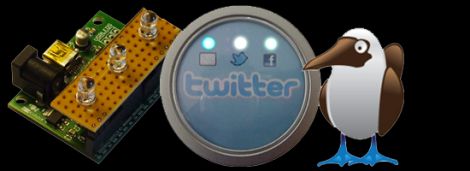
The team over at Archonix frequently challenge themselves to create a full working project in under 20 minutes. [Andrew Armstrong] put together a blog post detailing their most recent “Quickproject” – a simple Twitter notifier built using their Boobie Board.
They started by putting together a small notifier breakout module that could later be attached to their Boobie Board. The module is pretty simple and includes a trio of LEDs to alert you to activity across several online services, though only the Twitter notification module is currently complete. The notifier’s code was written in LUA, and primarily designed to interact with Linux desktops. They do not currently have a Windows compatible version of the code available, but they are more than happy to host it if someone desires to port their code over.
The notifier was put into an old candy tin with a plastic window, which is perfect fit for their project. All in all, the entire thing took them about 40 minutes, with half spent on hardware, half on code. The notifier does just what it was intended to do, but they have a healthy list of improvements that they would like to add, including the use of the other two notifier LEDs.















Haha, boobie.
Beat me to it :p
haha, that’s what i thought.
but i was too embarresed to write it.
btw site is down :/
Very funny.
But their site is not at home. I suspect its off on a dinner break. Or worse.
You can do the same using phidgets too. here is the documentation: http://www.uthcode.com/blog/2011/04/tweets-on-phidget-LCD-using-python
Is it just me, or is there no way to buy a boobie board on the whole website?
It looks like you can’t buy these boards anywhere, no-one knows pricing, the software on Instructables is alpha, and there is nowhere a precise definition of what the board actually does (apart from vaguely being a i/o pin driver via a usb serial port with some simple Lua demo software).
I’d guess this is some guy’s attempt at market research for a simple sub-Arduino project to see if there is sufficient latent demand before setting up production and a supply channel.
Hi guys, sorry if our site was down I think our host gets overloaded from time to time.
The Boobies are currently in their final stage of production with final revision hardware (much better than whats on the site) hence no shopping cart, however, I can see now it is best to let potential customers know this and I will mention it on the site.
Cheers,
Andrew
Boobie? Well, something get’s into my mind but I believe they refer to this http://www.galapagos-inseln.net/blaufusstoelpel-blue-footed-boobie/
@con-f-use, on the main page for the product it says you have to email them for pricing and availability, which suggests to me they’re prohibitively expensive for hobbyists.
With regards to Haku’s comment about the price, I can assure they are not prohibitively expensive – our target market is hobbyists.
It is just that we have not started shipping yet.
Incidentally, if anyone wants to leave a message in the appropriate section in our forum (under Boobie Boards – Beta Testers) there as a chance they will receive free hardware when we start shipping.
Andrew
Andrew, please let us know what processor chip this is based on.
LeftyX with regards the processor I have not mentioned it as I am still confirming the final design, but as it stands it is a PIC16F688 with all pins available on the header.
In the case where there are already peripherals fitted on the board such as oscillator, USB converter (FTDI RS232R), these can all be disconnected via solder-jumpers so the user has full control in their own designs.
There is also a programming header that will accept any of the recent microchip ICD programmers and the pickit2.
What is not shown are the accessories, I will be updating the site to show these, the most important of these is a the development board and enclosure. The enclosure has laser cut end panels so your projects can be professionally finished.
This is to allow the more advanced hobbiest to “finish” their project.
With regards the software being in alpha, its just open source sample code we have released as an API to your desktop. We do not define how the user has to interface to the boards, however we do pre-program them with a basic interface so that you can use the boards out of the box.
For the most part, it is how we end up using the boards ourselves, rarely dipping into programming the boards directly. The headers are very development board friendly.
Occasionally we do program them directly when experimenting, e.g. to play a tune on a piezo element, read/write to an SD card, perform some basic signal processing.
Andrew
Thanks, Andrew; info like that on a detail page on the website would be good, as would some description of the “basic interface” that you intend.
Remember, if you’re marketing to hobbyists, they’re infovores.
I’d be interested in picking up a couple if the price point is reasonable compared to competitors – bit whackers and servo controllers can be had between £9 and £20 or so in the UK – it’s always nice to see local stuff.
boobie board?
want one.
Thanks to all the Beta testers for their support, we are happy to announce the production units are now available.
Latest revision Boobie Boards now available at http://www.archonixtech.com
There is a GIT source repository being kindly hosted at https://github.com/lokidokicoki/boobie
Thanks,
Andrew